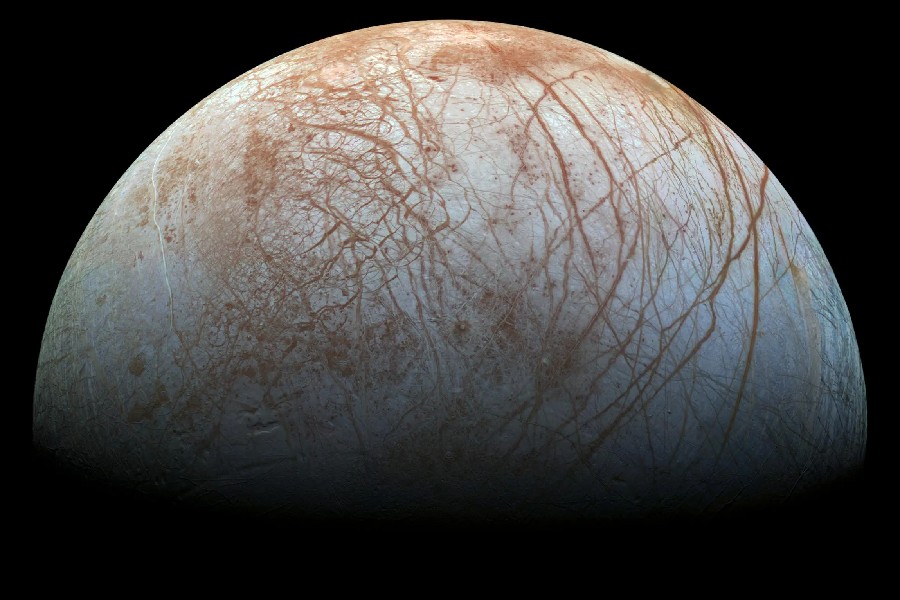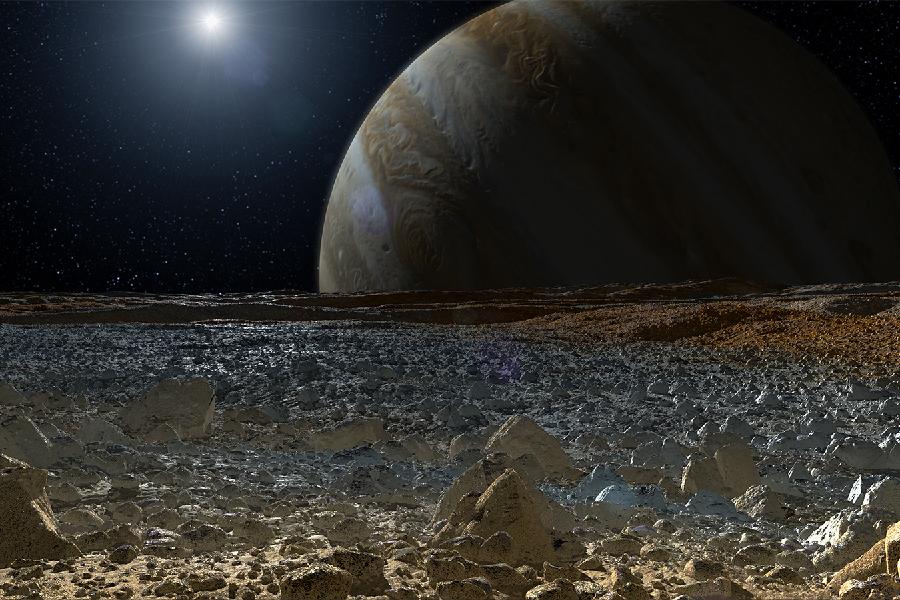Few of Jupiter’s 79 known moons present more intrigue than ice-sheathed Europa. Long suspected of harboring a vast subsurface ocean, Europa’s frozen crust conceals a global sea twice the size of our planet’s total surface water. But what are some significant Europa moon facts? When was Europa discovered?
In this article, we will explore the discoveries that have enhanced our understanding of Europa’s moon size and its intriguing ocean world. Gain insights into Europa’s potential habitability by delving into its orbital resonance with Io and assessing the depth of subsurface liquid layers.
Europa Moon Facts
Europa stands out for its potential habitability among Jupiter’s diverse family of satellites. Galileo Galilei discovered Europa on January 8, 1610. But what is Europa made of? Well, it is primarily composed of a rocky mantle and a subsurface ocean beneath an icy crust.
As a moon with an icy exterior, it might have a subsurface ocean beneath a 10 to 15-mile-thick layer of ice. Its relatively smooth surface, showing few impact craters, suggests an ongoing geological activity that has piqued scientists’ interest in the possibility of life-friendly conditions.
Scientists are particularly intrigued by the idea of a hidden ocean on Europa, seeing it as a potential habitat for microbial life. This curiosity has spurred researchers to delve deeper into the mysteries surrounding Europa.

Europa’s Ice Shell: A World of Mystery
Intriguing ice shell
Europa boasts a bright surface covered by a shell of water ice, ranging from a few to tens of miles thick. This icy crust hides a vast saltwater ocean on a global scale, believed to be beneath it. This ocean is influenced by tidal heating from Jupiter.
The chaotic terrain on Europa’s surface, characterized by ridges and disrupted bands, reveals processes occurring externally and within Europa’s outer ice layers. These features provide insight into the complex interactions shaping the moon’s landscape.
Exploration of ice thickness and composition
Geologic features support an ice shell that averages 11-15.5 miles in thickness, containing high concentrations of salts from ocean solutes. Variations in surface relief indicate regional deformation, pointing to slushy ice dynamics or the possible formation of a melt lens.
This deformation influences material exchange between the ocean and the surface. The ice sheet rests upon a rocky interior tapering oceanward, reaching just a few miles at the seafloor interface.
Implications for subsurface oceans
Europa’s thin yet active ice shell allows potential ocean material to vent through surface fractures and ridges. This creates two potentially habitable environments—above the ice and below the marine depths.
For these hydrothermal vent ecosystems to be sustainable in a lightless ocean sealed by thick ice, appropriate energy sources are essential. The ice shell is crucial in regulating the ocean’s chemistry in this context.
Subsurface Oceans: The Hidden Depths of Europa
Supporting evidence for subsurface oceans
Magnetic field variations around Europa suggest the presence of conductive fluid beneath its icy surface, possibly saltwater. Tidal flexing also generates sufficient heat to sustain a liquid ocean. Based on modeled thicknesses, gravity data indicates Europa likely has an ocean around 62 miles deep, covering most of the moon.
Extraterrestrial life possibilities
Europa, a moon of Jupiter, boasts a planet-wide salty ocean holding twice as much water as Earth’s surface. This vast ocean presents potential habitats for microbes, but only if essential energy sources are present.
Jupiter’s gravitational pull causes Europa’s rocky core to contract and expand, possibly forming hydrothermal vents like Earth’s oceans. These vents can supply the necessary chemical nutrients for life.
Simultaneously, reactions between seawater and heated underground rock could produce geothermal heat, serving as another potential energy source. Both these processes are known to sustain marine vent ecosystems on Earth. Additionally, material exchange is likely between Europa’s oceans and surface.
Europa’s Magnetic Field: A Puzzling Enigma
Examination of Europa’s weak magnetic field
In contrast to iron-rich planetary magnetic induction, Europa exhibits only a weak induced field – indicating conductive subsurface liquid rather than a sail-generated dynamo. Modeling suggests a conductive layer extending toward Jupiter to approximately 56 miles (90 kilometers), compatible with estimated ocean depths.
Mysteries of magnetic field origins
There’s ongoing confusion about where Europa’s magnetic field comes from and if the data is reliable. The measurements are sporadic and limited because radiation interference poses serious technical challenges.
The orbital geometry further complicates the magnetic analysis. Future probes will need to employ new techniques to address and overcome these issues. They must overcome these challenges using new techniques to uncover if Jupiter or a subsurface ocean causes the observed anomalies.
Implications for understanding Europa’s interior
A saline-rich ocean would be conductive enough to explain Europa’s weak magnetic signals. But mysteries continue surrounding the oceanic depths and conductivity profile. Also, it’s unclear if a thin, overlying ice shell permits a local dynamo contribution.
So, direct electromagnetic ice sounding from a dedicated multi-flyby orbiter could unveil key insights into Europa’s enigmatic ocean environment. This orbiter could relay data to Earth through quiet solar system latitudes. The exploration could provide valuable insights into the effects of Jupiter’s massive magnetosphere on Europa’s enigmatic ocean environment.

Potential for Life on Europa: The Astrobiological Frontier
Conditions for life on Europa
Europa likely has favorable conditions, such as liquid water, biogenic elements, and energy sources supplied by Jupiter’s tidal kneading. Radioisotopes drive subsurface heating, while chemical imbalances offer the potential for metabolism.
This environment is similar to seafloor hydrothermal ecosystems but exists in icy darkness. If vent-like conduits extend to the seafloor, microbes could thrive without sunlight.
Astrobiology of Europa’s subsurface oceans
Europa offers the best opportunity for finding extraterrestrial life beyond Earth, and this breakthrough could happen in the coming decades. As robotic technology and instruments advance, scientists may soon directly sample the plumes on Europa, map its seafloor, and potentially retrieve and analyze materials from its ocean depths.
Biosignatures: A life indicator search
Cryovolcanism can transport microbes and biomarkers to the surface, such as lipids, proteins, and metabolic byproducts. Space probes could collect these compounds when they reach the surface, and future landers can analyze the surface chemistry to detect them.
This approach could help identify signs of a living ocean on Europa without having to drill into the crust. As a result, there’s a push to develop biotechnology tools for missions that can remotely sense these novel biochemistries. This advancement could provide evidence for either a second genesis of life or panspermia.
Geysers of Europa: Icy Plumes in the Void
Water vapor plumes on Europa’s surface
Europa boasts towering geysers reaching 200 km (120 mi) in height, sporadically erupting as internal heat vaporizes subsurface lakes. This brief eruption sends water ice, salts, and potential biosignatures into the air above the moon’s surface.
The activity of these geysers appears to be influenced by Europa’s orbital distance, suggesting a role for tidal flexure in periodically facilitating the partial melting of the ocean beneath the frozen surface. The resulting ascension of water towards surface fissures contributes to creating these stunning plumes.
These icy cryo geysers are crucial evidence supporting the presence of internal liquid reservoirs within Europa’s layers of ice. The existence of natural conduits within the ice shell allows for periodic upwelling, suggesting dynamic transport growths and hinting at the possibility of life in the potentially inhabited ocean depths.
Plume sampling: Signs of life
Studying the active aqueous plumes on Europa from above seems simpler than sending probes beneath its icy surface to explore potential life forms in the dark seafloor ecosystems. As scientists pinpoint the locations of these vents, they can plan future missions to collect samples of water droplets, salts, microbes, or even biomolecules.
Observations of geysers suggest that Europa isn’t just a frozen world but an ocean world covered in ice, with occasional bursts of materials from its depths reaching the surface. This gives hope to capture and study signs of life from this alien ocean by tracking these geysers across Jupiter’s most fascinating moon.
Conclusion
Exploring the Europa moon facts, one of Jupiter’s moons, reveals its significant role in the search for extraterrestrial habitats. Despite its small size, Europa’s possession of a vast internal ocean adds to its astrobiological potential.
There’s a possibility of hydrothermal or rock-water reactions occurring in the dark ocean depths, which could serve as potential energy sources. These conditions might sustain alien ecosystems, mirroring the circumstances that kickstarted early life on Earth.
Our exploration aims to share current knowledge and address lingering mysteries surrounding Europa. By doing so, we aim to cultivate an appreciation for how this small moon raises profound questions about our position in the cosmos and the origins of life.
